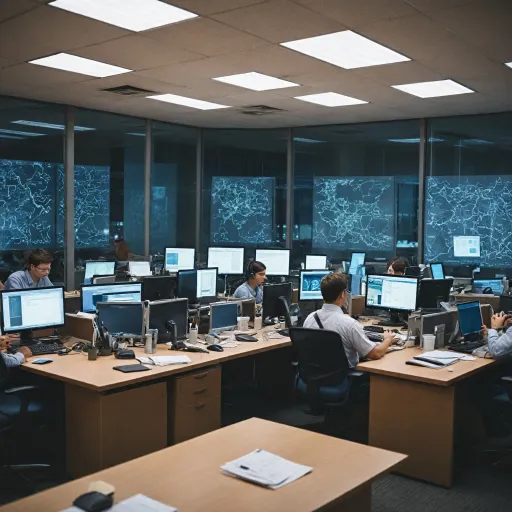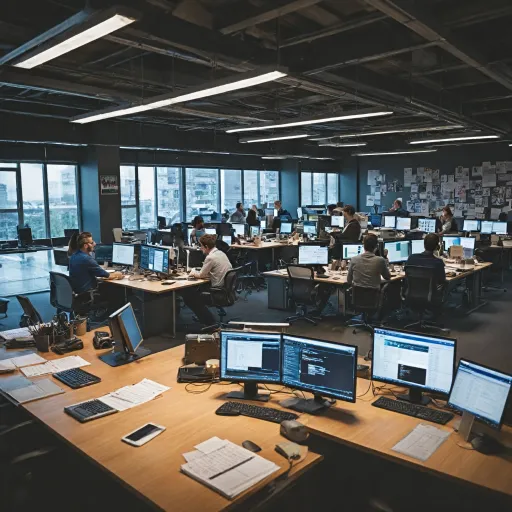AI in Identifying Hostile Work Environments
Unmasking Hostile Work Environments with AI
Artificial Intelligence (AI) is becoming an indispensable tool in identifying hostile work environments by monitoring patterns and behaviors that may indicate workplace harassment or discrimination. AI systems can analyze vast amounts of data swiftly, recognizing trends that may go unnoticed by human eyes. This efficiency helps with compliance to federal laws and anti-harassment policies that aim to protect employees.
A toxic workplace frequently emerges from persistent conduct that is severe and pervasive, creating emotional distress for employees. By incorporating AI, employers have a heightened ability to detect such conduct before it escalates into a hostile environment that violates laws. These AI systems can provide insights into potentially harmful dynamics in the work environment, helping to prevent a hostile workplace before it requires legal intervention.
Through the vigilant monitoring of communication patterns and employee interactions, AI can identify subtle signs of harassment-based misconduct, offering a layer of protection for individuals with a protected characteristic. For instance, predictive analytics can highlight the likelihood of workplace harassment occurrences, based on past incidents or similar work environment scenarios. In this way, AI not only uncovers hostile environments but also aids in shaping preventive strategies to foster a safer workplace.
While AI's capabilities in uncovering a toxic work culture are significant, it is crucial to combine these technological advances with the human element of emotional intelligence and sensitivity. Employers must navigate AI monitoring with ethical considerations to ensure privacy and respect for all employees, avoiding a scenario where they might inadvertently create a hostile work environment themselves.
Balancing innovation and empathy in AI’s application is pivotal for improving workplace relations in an era where ai ethics is increasingly scrutinized. Indeed, exploring perspectives such as whether
DEI is fading in the modern workplace showcases the ongoing evolution of AI's role in managing workplace dynamics effectively.
Preventive Measures with AI
Mitigating Hostile Workplaces with Artificial Intelligence
Artificial Intelligence (AI) has transformed the landscape of human resources by implementing preventive measures to curb workplace harassment and discrimination. Employers are increasingly leveraging AI to maintain a healthy work environment and address issues before they escalate into legal challenges.
One way AI aids in preventing a hostile environment is through analyzing employee interactions. By assessing communications and behavior, these systems can identify patterns indicative of workplace harassment or hostile conduct. For instance, AI can detect toxic language or consistency in negative interactions, prompting timely intervention by HR professionals before conditions worsen and lead to emotional distress for employees.
AI systems can also ensure compliance with workplace-related federal laws such as those enforced by the Equal Employment Opportunity Commission (EEOC). They can track and maintain records of employee conduct, helping to consistently enforce anti-harassment policies. This proactive approach not only helps prevent a hostile workplace but also provides a robust defense should any legal claims arise.
Moreover, AI can assist employers in educating their workforce by providing training modules on recognizing and combating harassment. This ensures that both employers and employees understand their rights and obligations, further reducing the likelihood of a toxic workplace.
For more detailed insights on addressing workplace threats with AI, you can refer to this comprehensive article on
role of AI in handling violent threats against management.
AI's Role in Legal Proceedings
The Intersection of AI and Legal Proceedings: Shaping the Future of Workplace Conduct Cases
Artificial intelligence has increasingly become a pivotal tool in legal proceedings related to workplace harassment and discrimination. It offers significant benefits in cases that involve hostile work allegations by organizing and analyzing vast amounts of data effortlessly and efficiently.
AI can provide critical evidential support by ensuring that all recorded instances of misconduct, harassment, or discrimination are duly documented and accessible during legal cases. This technological advancement plays a vital role in helping employment lawyers prove hostile work environments. By laying bare patterns of improper conduct, AI aids in arguing the severity and pervasiveness of the hostile workplace conditions, which is crucial in employment cases.
Furthermore, AI assists in maintaining a compliant work environment by highlighting any indicators of inappropriate interactions that could develop into severe or pervasive issues, thereby becoming potential legal challenges. Employers can mitigate risks of violating law by regularly using AI reports to ensure that workplaces are free from harassment based on protected characteristics.
For instance, federal law requires that employers provide a safe and harassment-free environment. In cases where AI can demonstrate a pattern of neglect or tolerance towards workplace harassment, such neglect could support an employee's decision to sue the employer for emotional distress. Analyzing records of previous incidents, AI can identify trends that go unnoticed in hostile workplace environments.
AI's ability to organize forensic evidence presents a structured framework for creating legal defenses or pushing for settlements. Employers are more likely to comply with EEOC-guided anti-harassment measures when the fear of legal repercussions is pre-emptively addressed.
For more insights on these critical matters, explore how AI-driven HR processes are reshaping workplace relations through
navigating the world of contingent job offers. Each step reinforces the importance of maintaining a workplace free from toxic influences by further empowering AI in employment-related legalities.
Ethical Considerations in AI Monitoring
Ethical Considerations and Responsible Use
When discussing the implementation of artificial intelligence in identifying and addressing a hostile work environment, it is crucial to consider the ethical implications. AI-driven monitoring systems can inadvertently invade employee privacy, leading to concerns about autonomy and dignity. Employers must balance the need for effective monitoring with respect for their employees' rights.
AI tools can gather extensive data from communication and behavior patterns to detect workplace harassment, workplace conduct, and other signs of a toxic work environment. However, it is essential to ensure that this data collection does not disproportionately impact individuals based on protected characteristics, such as gender, ethnicity, or age. Failing to account for these factors can lead to bias and discrimination, further complicating employment-related issues.
To navigate these challenges, organizations should:
- Implement transparency policies to provide employees with clear insights about monitoring practices.
- Ensure compliance with federal laws and employment laws related to data privacy and anti-harassment measures.
- Regularly audit and evaluate AI systems to identify biases and correct inaccuracies.
An ethical framework also involves engaging employees and experts in discussions about AI use in the workplace. Encouraging this dialogue can help foster an environment that not only minimizes harassment but also avoids creating a hostile workplace or emotional distress, by ensuring systems are fair and non-intrusive. Moreover, companies should involve employment lawyers in the development or selection of AI tools to avoid unintentional violations of laws and to better prepare for potential lawsuits, such as those involving claims of a hostile workplace, harassment based on a protected characteristic, or toxic work environments.
Lastly, organizations need to consider the potential emotional impacts on employees being monitored by AI systems. The perception of constant surveillance can create a work environment that feels hostile or toxic, even if it is intended to protect them from more severe, pervasive issues.
By prioritizing ethical considerations, companies can better use AI to foster a safe and supportive workplace without compromising their employees' trust and well-being.
Training AI for Sensitivity and Bias
Enhancing AI with Emotional Sensitivity
Training artificial intelligence to understand the nuances of workplace interactions is a crucial step in its deployment for identifying and mitigating hostile work environments. While technology can efficiently detect certain patterns consistent with harassment or discrimination, it requires guided tuning to be sensitive to subtle behaviours that contribute to a toxic workplace.
To develop AI systems that accurately assess work environments, they must be trained using diverse data sets that include both common and nuanced forms of undesirable conduct. For instance, it's imperative for AI to differentiate routine professional criticism from actions that create a hostile workplace through discrimination or emotional distress.
Avoiding Bias in AI Systems
Bias in AI is a significant concern, particularly when monitoring workplace conduct. AI systems must be trained meticulously to avoid reinforcing existing biases that could lead to unfair treatment based on protected characteristics such as race, gender, or age. This calls for an ongoing review and updating of the data sets AI is trained on, ensuring they remain inclusive and representative.
Moreover, developers and employers need to collaborate closely with employment lawyers to ensure AI systems comply with federal law and do not unintentionally violate laws protecting employees from discrimination and harassment. This collaboration is key in proving hostile environments damaging to the employees and ensuring the systems are geared towards protecting employees' legal rights.
The Human Element in AI Monitoring
Despite AI's potential in detecting workplace harassment, its deployment should complement, not replace, human oversight. It's essential to provide a balanced approach where human evaluators can interpret AI-gathered data with emotional intelligence that machines currently lack. This ensures that findings from AI are considered within the broader context of each unique case, acknowledging any emotional distress experienced by employees.
In summary, as AI continues to evolve in the realm of workplace relations, the focus should remain on developing systems that are both technically adept and emotionally perceptive. This dual focus ensures that AI truly enhances the workplace experience by creating safer, more inclusive environments devoid of harassment and discrimination.
Future Trends in AI and Workplace Relations
A Glimpse into Tomorrow: How AI is Revolutionizing Workplace Relations
The future of artificial intelligence in workplace relations presents an evolving landscape filled with opportunities to enhance employee well-being and legal compliance. As organizations continue to explore the capabilities of AI in mitigating hostile work environments, several advancements and trends are emerging.
First, AI technology is anticipated to become increasingly integral in real-time monitoring and analysis. With the ability to detect patterns indicative of workplace harassment and discrimination, AI systems could potentially alert employers to developing issues before they escalate. This proactive approach could help create a toxic work environment resistant to suppression and lead to a more harmonious and productive employment atmosphere.
Another future trend lies in the personalizing of AI solutions. Just as detecting harassment based on a protected characteristic—such as gender, ethnicity, or religion—requires nuance, AI systems should be tailored to reflect the unique conduct standards and cultures of different organizations. As a result, businesses could customize AI tools to better address specific challenges related to their work environment.
Moreover, the expansion of AI's role in resolving workplace disputes and assisting legal processes is on the horizon. AI could further its role by providing detailed analyses and reports useful in legal investigations of a hostile environment or discrimination claims. This, in turn, could streamline proving a hostile work case process and offering evidence that emotional distress or severe pervasive occurrences have taken place.
On the horizon, we also see a shift towards ethical AI development. Continuous effort to program AI systems with sensitivity and avoidance of bias helps to ensure these tools do not inadvertently violate law or overlook harassment workplace incidents. Integrating these systems ethically is crucial to fostering an environment that prevents discrimination and aligns with federal law and EEOC guidelines.
In conclusion, as AI technology progresses, it remains crucial for organizations to stay informed about its capabilities and implications in human resources. By doing so, they can better navigate the complexities of maintaining a legally compliant and emotionally supportive employment setting. The way forward lies in embracing these technological tools, while balancing legal and ethical considerations, to enhance workplace relations and ultimately, employee satisfaction.













